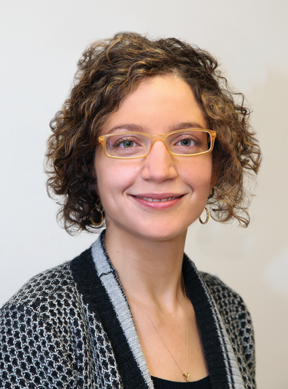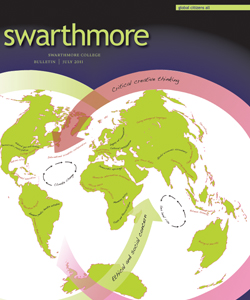Global Curriculum
“What Do We Owe Distant Strangers in Need?”
 Ayse Kaya, assistant professor of political science, designed the course Globalization with the aim of having students examine the many dimensions of an interdependent world, including politics, economics, culture, and the environment. Her students learn about political-economic globalization; discuss changes to state sovereignty and autonomy; analyze key international and regional organizations; examine the role of the United States in globalization (“Good and bad,” she says); assess multilateral attempts to govern environmental issues; and read about changing power dynamics in the international system. Through group presentations, they also explore related issues such as globalization and soccer, intellectual property rights and access to medicine in developing countries, and public opinions on globalization.
Ayse Kaya, assistant professor of political science, designed the course Globalization with the aim of having students examine the many dimensions of an interdependent world, including politics, economics, culture, and the environment. Her students learn about political-economic globalization; discuss changes to state sovereignty and autonomy; analyze key international and regional organizations; examine the role of the United States in globalization (“Good and bad,” she says); assess multilateral attempts to govern environmental issues; and read about changing power dynamics in the international system. Through group presentations, they also explore related issues such as globalization and soccer, intellectual property rights and access to medicine in developing countries, and public opinions on globalization.
Yet Kaya cautions that “globalization is not always about the global. It requires us to know more about the national and the local in different parts of the world, where its transformative effects blur the traditional distinctions between the domestic and the international, between the national and the foreign.”
She says many students have been drawn to the study of international organizations such as the World Bank or the International Monetary Fund. “They’re sensitive to both the extent of United States influence on these organizations and the power asymmetries inherent in them,” she says.
Students read works with different emphases about globalization, such as Nobel Prize winner Joseph Stiglitz’s Making Globalization Work (2007) and Martin Wolf’s Why Globalization Works (2004). Although students tend to have strong views at the start of the course about the pros and cons of globalization, these views often change as they learn about the complexities facing an interdependent world.
“Swarthmore students are passionate about issues that they see as integral dimensions of globalization, ranging from sustainability to social and political development, to economic and social inequalities,” Kaya says. “They see that although globalization offers a wealth of opportunities for some, it’s radically changing the lives of others who may not have a voice.”
The study of globalization includes many normative questions, says Kaya, who grew up in Turkey, then received a bachelor’s degree from Wellesley College and a Ph.D. from the London School of Economics. For instance, addressing the philosophical question of “What do we owe to distant strangers in need?” is essential to most class discussions of globalization, including those on foreign aid and the design of multilateral institutions—and it’s a question that especially resonates with Swarthmore students. “From an ethical perspective,” Kaya says, “globalization pushes us to question the boundaries of our moral obligations.”
—Jeffrey Lott
Why Language Study Changes—and Expands Beyond Just Language
The 1961 course catalog lists language and literature courses in four modern languages—French, Spanish, Italian, and German. By 2011, although Italian is no longer offered, Russian, Arabic, Chinese, and Japanese languages and literatures have been added to the other three options, making a total of seven modern languages available to Swarthmore students. We asked Sibelan Forrester, chair of modern languages and professor of Russian, for her opinion on why changes in language study occur.
Interest in languages rises and falls in connection to world events and economic interests. Some students come to a language because of its cultural importance or because they know someone who speaks it and want to speak with that person, but I think most students want some practical utility—even if the “use” is to further a passion for art, ballet, music, or literature.
The academic interests of members of the Modern Languages Department extend around the world, though, far beyond the languages we teach—from other languages that are close to the ones we teach (such as Catalan or Cantonese) to languages we teach only as directed readings or literatures/films we get to teach only in translation. For example, in spring semester 2012, Associate Professor of French Carina Yervasi and Associate Professor of German Sunka Simon are planning an exciting new course that will connect their students with students in Ghana.
Another big difference in modern languages today is that every section offers some literature courses taught in English; and English translations are used for most of the literature/film teaching in the case of languages that are less similar to English—we don’t like to say they’re “harder,” because they’re not harder “intrinsically”; it’s just that a speaker of English already “knows” more French or Spanish or German before beginning to learn them.
Although the American Association of French Teachers argues that Spanish is no longer a foreign language in the United States—which would make French the most commonly taught language—big growth languages for us currently are Spanish and Mandarin Chinese because of strong numbers of heritage students and economists’ predictions that China will be the next dominant power in the world.
FACTOID: In some recent years, more Swarthmore students have majored in Chinese than in any other foreign language offered at the College
 Email This Page
Email This Page